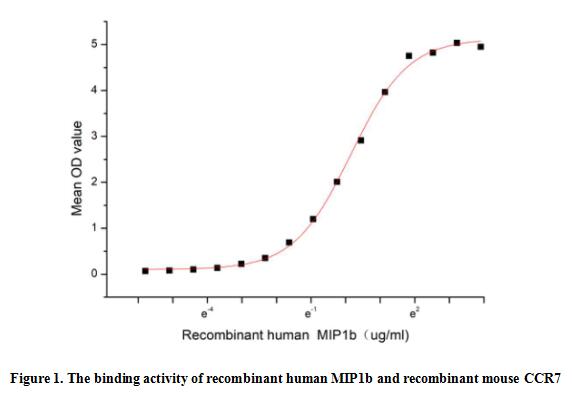Active Macrophage Inflammatory Protein 1 Beta (MIP1b)
CCL4; ACT2; G-26; LAG1; MIP1-B; SCYA4; Chemokine C-C-Motif Ligand 4; Small Inducible Cytokine A4; Homologous To Mouse Mip-1b
- Product No.APA093Hu61
- Organism SpeciesHomo sapiens (Human) Same name, Different species.
- Buffer FormulationPBS, pH7.4, containing 5% Trehalose.
- Traits Freeze-dried powder
- Purity> 95%
- Isoelectric Point4.5
- ApplicationsCell culture; Activity Assays.
- DownloadInstruction Manual
- UOM 10µg50µg 200µg 1mg 5mg
- FOB
US$ 220
US$ 550
US$ 1100
US$ 3300
US$ 8250
For more details, please contact local distributors!
ACTIVITY TEST

Macrophage Inflammatory Protein 1 Beta (MIP1b), also known as CCL4, is a cytokine belonging to the CC chemokine family that is secreted at sites of inflammation by activated leukocytes, lymphocytes, vascular endothelial cells, and pulmonary smooth muscle cells. As a chemokine, MIP1b binds to the G-protein-coupled receptors CCR5 and CCR8, acting as a chemical attractant for natural killer cells, monocytes, and various other immune cells at sites of inflected or damaged tissue. At the same time, MIP1b can also retain the abilities to induce down-modulation of surface expression of the chemokine receptor CCR5 and to inhibit the CCR5-mediated entry of HIV-1 in T-cells. Chemokine C-C-Motif Receptor 7 (CCR7) can interact with MIP1b.Thus a functional binding ELISA assay was conducted to detect the interaction of recombinant human MIP1b and recombinant mouse CCR7. Briefly, biotin-linked MIP1b were diluted serially in PBS, with 0.01% BSA (pH 7.4). Duplicate samples of 100 ul were then transferred to CCR7-coated microtiter wells and incubated for 1h at 37℃. Wells were washed with PBST 3 times and incubation with Streptavidin-HRP for 30min, then wells were aspirated and washed 5 times. With the addition of substrate solution, wells were incubated 15-25 minutes at 37℃. Finally, add 50 µL stop solution to the wells and read at 450/630 nm immediately. The binding activity of recombinant human MIP1b and recombinant mouse CCR7 was shown in Figure 1, the EC50 for this effect is 1.17 ug/mL.
USAGE
Reconstitute in 10mM PBS (pH7.4) to a concentration of 0.1-1.0 mg/mL. Do not vortex.
STORAGE
Avoid repeated freeze/thaw cycles. Store at 2-8°C for one month. Aliquot and store at -80°C for 12 months.
STABILITY
The thermal stability is described by the loss rate. The loss rate was determined by accelerated thermal degradation test, that is, incubate the protein at 37°C for 48h, and no obvious degradation and precipitation were observed. The loss rate is less than 5% within the expiration date under appropriate storage condition.
GIVEAWAYS
INCREMENT SERVICES
-
 BCA Protein Quantification Kit
BCA Protein Quantification Kit
-
 Molecular Mass Marker for Protein
Molecular Mass Marker for Protein
-
 Monoclonal Antibody Customized Service
Monoclonal Antibody Customized Service
-
 Polyclonal Antibody Customized Service
Polyclonal Antibody Customized Service
-
 Protein Activity Test Experiment Service
Protein Activity Test Experiment Service
-
 Electrophoretic Mobility Shift Assay (EMSA) Experiment Service
Electrophoretic Mobility Shift Assay (EMSA) Experiment Service
-
 Buffer
Buffer
-
 Lentivirus Packaging Experiment Service
Lentivirus Packaging Experiment Service
-
 Adenovirus Packaging Experiment Service
Adenovirus Packaging Experiment Service
-
 Real Time PCR Experimental Service
Real Time PCR Experimental Service
-
 Spike RBD Protein (S-RBD)
Spike RBD Protein (S-RBD)
-
 Protein G
Protein G
-
 Protein A
Protein A
| Magazine | Citations |
| Inhalation Toxicology | Age influence on hypersensitivity pneumonitis induced in mice by exposure to Pantoea agglomerans Pubmed: 24044680 |
| PLoS One. | Megakaryocytic leukemia 1 (MKL1) regulates hypoxia induced pulmonary hypertension in rats. Pubmed: 24647044 |
| PLOS ONE | Megakaryocytic Leukemia 1 (MKL1) Regulates Hypoxia Induced Pulmonary Hypertension in Rats Pubmed:Pmc3960100 |
| Cell Physiol Biochem | MicroRNA-155 Promotes Atherosclerosis Inflammation via Targeting SOCS1 PubMed: 26159489 |
| Am J Alzheimers Dis Other Demen. | Tong Luo Jiu Nao, a Chinese Medicine Formula, Reduces Inflammatory Stress in a Mouse Model of Alzheimer's Disease Pubmed:26993489 |
| Pharmacological Reports | The Association between Inflammatory Markers (iNOS, HO-1, IL-33, MIP-1β) and Depression with and without Posttraumatic Stress Disorder 10.1016:j.pharep.2018.06.001 |
| Metabolic Brain Disease | Neuroprotective effects of Bacopa monnieri in Parkinson's disease model Pubmed: 31834548 |







